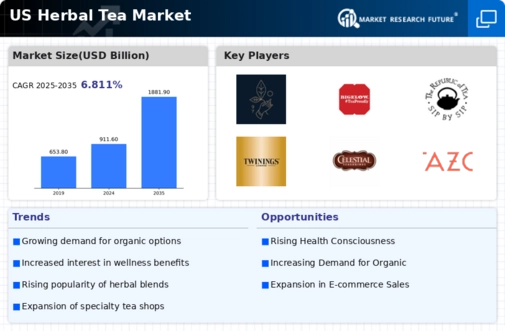The herbal tea market exhibits a dynamic competitive landscape characterized by a blend of innovation, sustainability, and strategic partnerships. Key players such as Twinings (GB), Celestial Seasonings (US), and Yogi Tea (DE) are actively shaping the market through diverse strategies. Twinings (GB) focuses on product innovation, introducing new flavors and blends that cater to evolving consumer preferences. Celestial Seasonings (US) emphasizes sustainability, sourcing ingredients responsibly and promoting eco-friendly packaging. Yogi Tea (DE) leverages its strong brand identity to expand its market presence, particularly in health-conscious segments. Collectively, these strategies foster a competitive environment that prioritizes quality and consumer engagement.
In terms of business tactics, companies are increasingly localizing manufacturing to enhance supply chain efficiency and reduce costs. The market structure appears moderately fragmented, with several players vying for market share. This fragmentation allows for niche brands to thrive alongside established names, creating a diverse product offering that appeals to a wide range of consumers. The collective influence of these key players drives innovation and shapes consumer expectations, further intensifying competition.
In October 2025, Twinings (GB) launched a new line of herbal teas infused with adaptogenic herbs, aiming to tap into the growing wellness trend. This strategic move not only diversifies their product portfolio but also positions Twinings (GB) as a leader in the health-oriented segment of the market. The introduction of adaptogens aligns with consumer demand for functional beverages, potentially enhancing brand loyalty and market share.
In September 2025, Celestial Seasonings (US) announced a partnership with a leading sustainability organization to enhance its sourcing practices. This collaboration underscores the company's commitment to environmental responsibility and may strengthen its brand image among eco-conscious consumers. By aligning with sustainability initiatives, Celestial Seasonings (US) could differentiate itself in a crowded market, appealing to a demographic increasingly concerned with ethical consumption.
In August 2025, Yogi Tea (DE) expanded its distribution channels by entering into a strategic alliance with a major online retailer. This move is likely to enhance Yogi Tea's visibility and accessibility, particularly among younger consumers who prefer online shopping. The partnership may also facilitate data-driven marketing strategies, allowing Yogi Tea (DE) to tailor its offerings based on consumer behavior and preferences.
As of November 2025, current trends in the herbal tea market indicate a strong emphasis on digitalization, sustainability, and the integration of AI technologies. Strategic alliances are increasingly shaping the competitive landscape, enabling companies to leverage shared resources and expertise. Looking ahead, competitive differentiation is expected to evolve, with a shift from price-based competition to a focus on innovation, technology, and supply chain reliability. Companies that prioritize these elements are likely to gain a competitive edge in an ever-evolving market.
























Leave a Comment